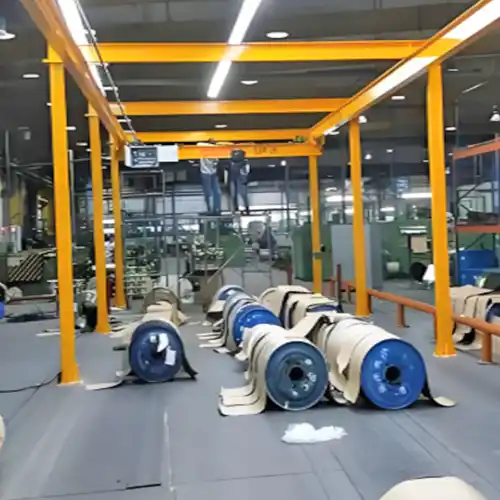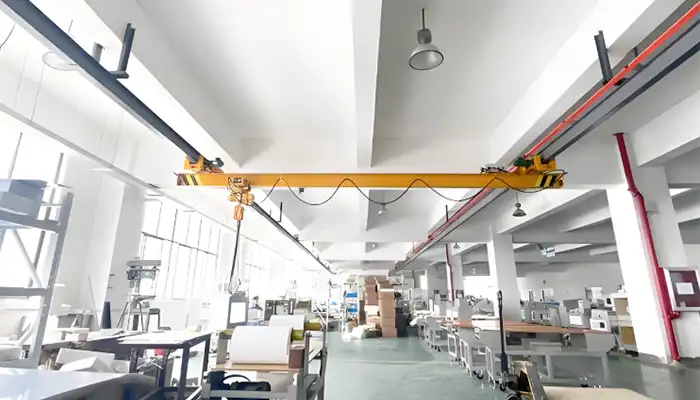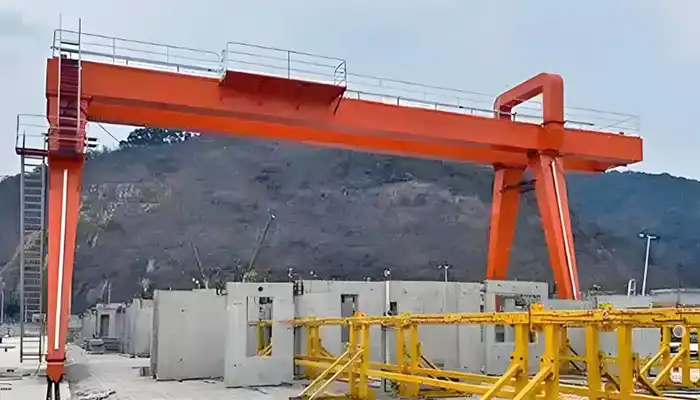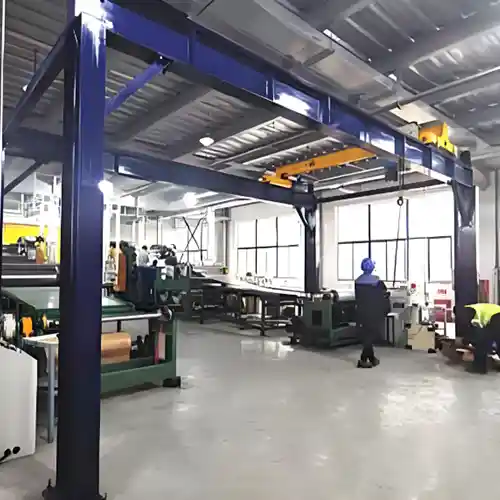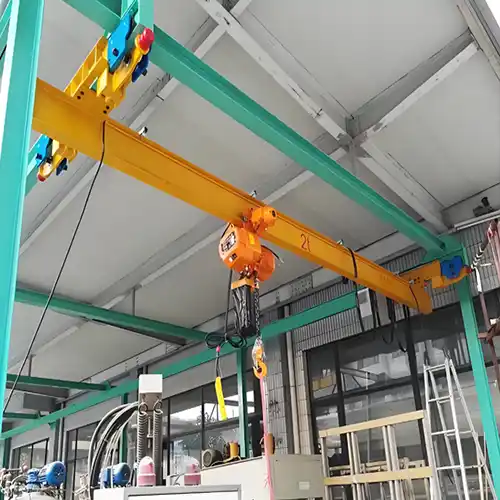Free Standing Bridge Cranes for Sale: Complete Buyer’s Guide
Explore features, specs, applications, installation tips & pricing to choose best free standing bridge crane for your uses.Get freestanding overhead crane!
Category: Featured
Your Trusted Freestanding Overhead Crane Manufacturer & Supplier
Free Standing Bridge Cranes for Sale: Complete Buyer's Guide
Introduction: What Is a Free Standing Bridge Crane?
If your workshop or factory floor needs lifting power but your building's structure can't support a ceiling-mounted system, a free standing bridge crane might be exactly what you're looking for.
A free standing bridge crane—sometimes simply called a free standing crane—is a type of overhead crane that's fully supported by its own structure. It doesn't rely on your building's walls or ceiling for support. Instead, it uses upright steel columns and a floor-mounted runway system to carry a bridge beam and hoist across the work area. This makes it a flexible solution for both new buildings and existing workshops where structural modifications are too costly or not even possible.
How It Works
- The crane's steel columns are bolted directly to the floor. No overhead tie-ins or roof beams are needed.
- A bridge (a horizontal beam) runs along these columns and moves side to side.
- A hoist travels along the bridge, lifting and moving loads across the bay.
- Operators can control the crane by pendant control, remote control, or a cabin if needed.
This type of crane is a good fit for buyers looking for an independent lifting system that doesn't rely on the strength of the building structure. It's often used when:
- The roof can't support added loads from a ceiling-mounted system.
- The building is rented or leased, so structural modifications aren't allowed.
- A flexible layout is needed, and the crane may need to be moved later.
- A dedicated crane is needed in one production zone without interfering with other areas.
Key Differences from Ceiling-Mounted and Gantry Cranes
It's easy to confuse free standing bridge cranes with other overhead systems like ceiling-mounted or gantry cranes. But each serves a different purpose:
- Ceiling-mounted bridge cranes share the same rail and bridge design but require support from building beams. These are harder to install in older or light-frame buildings.
- Gantry cranes have legs that run along the floor and sometimes take up more space. While great for outdoor or mobile use, they can be intrusive indoors.
In contrast, a free standing bridge crane offers overhead lifting power with a self-contained structure that works well inside buildings, especially those with no structural capacity to hold a crane.
It's not the flashiest piece of equipment, but it quietly does the heavy lifting—literally. Whether you're moving engine parts, welding beams, or fabricating metal panels, this kind of crane provides the support you need where your building can't.
Your Trusted Overhead Crane Manufacturer & Supplier
Freestanding Bridge Cranes for Sale
Typical Specifications and Configurationsof Freestanding Bridge Cranes
When planning to install a free standing bridge crane system, understanding the typical specifications is key to making sure it fits your workshop, production flow, and lifting needs. This section covers the core technical parameters you'll need to consider before purchasing or customizing your crane.
A free standing crane is highly adaptable. Whether you're outfitting a small machine shop or a large fabrication bay, the system can be configured to match your exact layout, ceiling height, and load handling requirements. Below are the main factors that shape the crane design.
Main Configurations of Freestanding Bridge Crane Systems
Freestanding bridge cranes come in a few key design configurations. Each type fits different facility layouts, load requirements, and working environments. Below are the most common types and what they're best suited for:
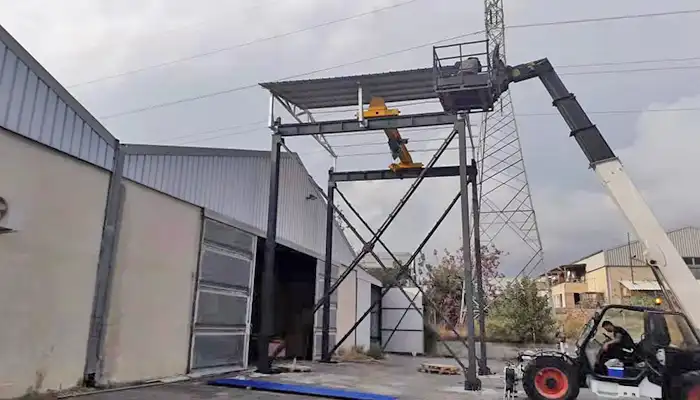
Freestanding Bridge Crane for sale with Top Running Crane Design
This setup is ideal when higher lifting height is needed. The bridge girder rides on top of the runway beams, maximizing headroom under the hook.
- Hoist Positioning: Hoist and trolley run on top of the bridge.
- Lifting Capacity: Typically supports heavier loads than underhung systems.
- Application Areas: Machine shops, maintenance bays, and production facilities with open floor space.
Advantages:
- More vertical lifting height
- Supports wider spans and higher capacities
- Easier to integrate with double girder designs if needed

Freestanding Bridge Crane for Sale with Underhung Crane Design
In this version, the bridge girder is suspended from the bottom of the runway beam. It's often used in low-ceiling buildings or lighter-duty tasks.
- Hoist Positioning: Hoist and trolley hang beneath the bridge girder.
- Structural Notes: Allows smoother operation and precise load placement due to lower dead weight.
- Application Areas: Assembly lines, workshops with limited headroom, or lighter lifting needs.
Advantages:
- Low-profile design fits tight vertical clearances
- Reduces stress on foundations due to lighter structure
- Simple installation and cost-effective

Heavy Duty Freestanding Double Girder Bridge Crane for Outdoor Use
For heavy outdoor work, especially in construction yards or raw material handling areas, a heavy-duty freestanding bridge crane with double girder structure is often required.
- Design Highlights: Dual girders provide better load distribution and support larger hoists.
- Runway Structure: Built with reinforced steel columns and beams, often fixed in concrete foundations to resist wind and outdoor exposure.
- Lifting Capacity: Suitable for 10 tons and up, including 20 ton, 30 ton, or more depending on structure.
- Application Areas: Steel yards, precast concrete plants, shipping terminals, and outdoor material storage sites.
Advantages:
- High load capacity and long span handling
- Suitable for frequent and tough operations
- Designed to withstand environmental conditions
Key Features of a Free Standing Bridge Crane
A free standing bridge crane isn't just another lifting tool—it's a practical system built to support daily industrial needs without relying on your building's structure. This type of crane brings together strength, flexibility, and simplicity in a way that makes it especially useful for workshops, warehouses, and manufacturing facilities where building modifications are either impossible or too expensive.
Self-Supporting Structure
One of the main advantages of a free standing crane system is its ability to stand on its own—literally.
- The system is built with heavy-duty steel columns that are anchored directly into the floor.
- No load is transferred to your building's roof or walls, which eliminates the need for reinforcement or structural assessments.
- This makes it ideal for rented facilities, aging structures, or any site with light roofing systems.
Modular Design for Flexible Layouts
Whether you're setting up a new shop or planning to grow in stages, the modular design of a free standing bridge system makes it easy to adjust as needed.
- Add more runway or bridge length when your production expands.
- Reconfigure or relocate the crane without a major overhaul.
- Match the crane layout to your process flow, not the other way around.
You don't have to redesign your facility to fit the crane—it can be built around your actual workspace and changed later if needed.
Compatible with Single or Double Girder Cranes
The system works with both single and double girder setups, depending on your lifting needs.
- Single girder cranes are great for lighter loads (up to around 10 tons) and are more cost-effective.
- Double girder cranes offer higher lifting capacities and increased hook height for heavier-duty applications.
- Your hoist and bridge type can be matched to your workflow, lifting frequency, and headroom.
This compatibility makes the free standing bridge crane system suitable for everything from basic machine shops to more demanding fabrication environments.
Smooth Travel and Optional Automation
These cranes are built for reliability and easy operation. Movement across the runway and bridge is controlled with smooth, precision motion, and automation options are available if you want to go hands-free.
- VFD (Variable Frequency Drive) control offers smooth acceleration and deceleration.
- Remote control systems reduce operator fatigue and improve safety.
- Optional semi-automatic or fully automatic control for repetitive tasks or high-volume handling.
Even in basic configurations, the crane moves with ease—something your operators will appreciate on long shifts.
Easy Installation and Low Maintenance
You don't need to shut down your whole facility for installation. These cranes are designed to go up quickly and stay in service with minimal fuss.
- Pre-engineered columns and runways reduce setup time.
- Can be delivered as a complete crane system or in kit form for local assembly.
- Grease points, motor access, and wiring systems are all designed for easy maintenance.
When you're running a busy workshop, the last thing you need is a crane that's hard to install or constantly breaks down. A free standing crane system is built to keep things moving—without dragging you into extra costs or downtime.
Main Parameters Affecting Freestanding Bridge Crane Designs and Configerations
Load Capacity
The load capacity of a free standing bridge crane typically ranges from 1 ton to over 20 tons.
- 1–5 tons: Common in maintenance areas, light manufacturing, and storage zones.
- 10–15 tons: Suitable for medium-duty production, metalworking, and assembly processes.
- 20+ tons: Used in heavy-duty applications such as mold handling, steel fabrication, and machinery loading.
It's important to choose a capacity that not only meets your current lifting needs but also allows for future growth. Always account for the heaviest load you plan to lift, plus a safety margin.
Span (Bridge Width)
The span refers to the distance between the two runway columns and typically ranges from 5 to 25 meters, though longer spans can be custom-built.
- Shorter spans (under 10 meters) are common in smaller work zones.
- Mid-range spans (10–18 meters) are typical for medium workshops.
- Wider spans (18–25 meters or more) are designed for large production floors or multiple workstations.
The span should match the width of your work area without exceeding what's necessary. Overbuilding adds unnecessary cost, while underbuilding limits your crane's usefulness.
Runway Length
A free standing bridge crane can be installed with runways up to 100 meters long—or even longer depending on your space and material handling flow.
- The runway defines how far the bridge can travel lengthwise across your shop.
- It's usually modular, so additional runway sections can be added later.
- Stops and sensors can be added to limit travel and improve safety at the ends of the runway.
If you plan to expand your production area, let your crane supplier know early so the system can be designed with future extensions in mind.
Height Under Runway Beam
The height under the runway beam (also known as the hook height or clearance height) should be customized to fit your building and lifting needs.
- Most systems range from 3 to 8 meters under the beam.
- Taller cranes (10 meters or more) are possible in larger facilities.
- The key is to ensure there's enough clearance for both the load and the hoist's lifting height.
Always measure the highest item you'll lift and ensure there's enough room for safe lifting and lower-level movement. Avoid leaving too little space—it can lead to inefficiencies and safety concerns.
Hoist Options
The electtic hoist for free standing bridge crane is the lifting unit mounted on the bridge, and it's available in various types to match the application:
- Wire rope hoists: Best for heavier loads, smoother lifting, and higher duty cycles. Ideal for frequent or heavy-duty use.
- Chain hoists: More compact and cost-effective for lighter loads and less frequent use. Easier to maintain and usually quieter.
- Speed options: Hoists can come with single or dual lifting speeds, or with variable frequency drives (VFD) for precision control.
Discuss your usage pattern with the crane supplier to select the right hoist. A mismatched hoist can either limit your efficiency or cost more than needed.
Control Methods
Free standing bridge cranes can be controlled in several different ways:
- Pendant control: Hard-wired to the hoist or trolley, simple and reliable. Best for small to mid-size cranes.
- Wireless remote control: Offers more flexibility and operator freedom, especially for larger cranes or when visibility is restricted.
- Cabin control: Used in very large systems, often in steel plants or heavy-duty handling zones where the operator needs full visibility and protection.
Your choice of control method depends on operator comfort, workspace layout, and safety concerns. Remote controls are becoming more common for ergonomic and operational flexibility.
By working with a supplier who understands these variables, you can build a free standing bridge crane system that fits your facility both physically and operationally. Providing detailed specifications from the start—such as load weights, bay width, and ceiling height—helps ensure a smooth and cost-effective process.
Common Applications
A free standing bridge crane is one of those tools that quietly makes everything in your facility run smoother—especially in spaces where the building just can't support the weight of a ceiling-mounted crane. Its self-supporting structure and flexible layout make it a practical choice in a wide range of industrial settings. If your work involves lifting, positioning, or moving heavy parts regularly, this type of crane is worth considering.
Below are some of the most common applications where a free standing crane system proves its value.
Manufacturing Plants and Assembly Lines
Production environments thrive on efficiency, and a free standing bridge crane supports that by enabling precise part movement between workstations.
- Ideal for moving semi-finished products between different production stages
- Reduces manual handling and risk of damage
- Keeps workflow organized without blocking floor space
Whether you're producing automotive parts, electrical components, or consumer goods, this crane system helps keep the line moving without delay.
Maintenance Shops and Repair Facilities
In maintenance zones, equipment and vehicles come in for servicing, and there's no time to waste struggling with awkward lifts.
- Lifts engines, pumps, gearboxes, and other heavy parts with ease
- Frees up forklifts for other tasks
- Can be installed directly over a maintenance bay or workbench
Even in a tight space, a free standing crane gives technicians full access to lift and position components safely and quickly.
Metal Fabrication and Welding Bays
Metalworking often involves handling long beams, heavy plates, or custom-fabricated parts that can't be moved by hand.
- Safely handles sharp, bulky, or hot materials
- Supports single or multi-station welding zones
- Offers steady movement for accurate positioning during weld-up
Because fabrication shops change layouts often, the modular nature of a free standing crane system is a strong fit.
Machinery Warehouses and Distribution Centers
Storage and logistics operations use cranes to manage heavy machinery, molds, dies, and large boxed equipment.
- Transfers items from racks to workstations or loading docks
- Reduces congestion caused by forklifts or carts
- Improves picking speed and protects valuable equipment during handling
For locations that don't have structural overhead crane support, this is a simple and effective alternative.
Facilities Without Structural Crane Support
Many older or rented buildings were never designed to hold the weight of a top-running crane. That's where this system shines.
- Requires no building modifications
- Avoids costly engineering upgrades or structural reinforcement
- Suitable for leased industrial units or modular factories
If you've ever looked at your ceiling and thought, "There's no way this could hold a crane," the solution is simple—build the crane from the ground up.
Whether it's improving safety, increasing productivity, or enabling better space utilization, a free standing bridge crane adapts to your operation and gives you lifting power right where you need it—without depending on your building to do the heavy lifting.
Installation Considerations
Installing a free standing bridge crane isn't as simple as dropping it into place and flipping a switch—but with the right planning, it's a smooth process. Since this crane type doesn't depend on your building structure, it gives you more freedom, but also requires attention to a few key setup conditions. Whether you're purchasing a complete crane system or assembling from a crane kit, these are the details you'll want to review before installation begins.
Floor Condition and Concrete Thickness
A free standing crane system puts all of its weight—and the load it carries—on the floor. That means your concrete needs to be strong enough to handle the load without cracking or settling.
- Most systems require a concrete slab thickness of 150–300 mm (6–12 inches), reinforced with rebar.
- The exact requirement depends on crane capacity, column spacing, and local soil conditions.
- If your floor isn't strong enough, you'll need to pour reinforced footings or base pads where columns will be anchored.
It's a good idea to have a structural engineer or the crane supplier review your slab specs before proceeding.
Layout Planning
You can't just place a free standing crane anywhere—it needs to fit your workflow and physical space. Take the time to plan your layout carefully.
- Determine the runway beam location and how much of the floor it needs to cover.
- Consider headroom—especially in facilities with low ceilings. You need enough clearance under the runway for safe lifting.
- Make sure the crane's bridge and hoist travel paths avoid obstructions like HVAC, lighting, or equipment.
A scaled layout drawing from your crane supplier can help visualize how the system will fit into your work zone.
Electrical Power Supply
Every crane needs power, and how you route and connect that power matters.
- Standard power for industrial cranes is typically 380V–480V, 3-phase, but this can vary by country or region.
- Make sure your facility has a dedicated power line available at the crane's runway start point.
- Some systems use cable festoons or conductor bars along the runway for safe and flexible power delivery.
- Controls, limit switches, and safety interlocks should also be properly wired and tested.
Plan ahead with your electrician to avoid delays during commissioning.
Installation Options
Depending on your location, budget, and in-house capabilities, there are a couple of ways to approach installation:
- Turnkey installation: The crane supplier handles everything from delivery to final testing. This is faster, ideal for buyers who want a hands-off approach.
- Crane kit + local fabrication: The supplier provides the crane components (hoist, bridge, trolleys, etc.), and you fabricate and install the supporting structure locally. This is often more economical for overseas buyers or companies with engineering teams.
In either case, proper instructions, drawings, and coordination with riggers or installers are key to success.
Timeframe for Installation and Commissioning
Timelines can vary depending on crane size, site conditions, and scope of supply. But here's a rough idea of what to expect:
- On-site installation: Typically takes 2–7 days, depending on size and complexity.
- Load testing and fine-tuning: Adds 1–2 days to ensure safety and functionality.
- Lead time before installation: Factor in manufacturing (2–6 weeks), shipping, and site prep.
It's best to coordinate installation during low-production periods or shutdowns, especially if your facility has limited access or operating space.
Taking the time to properly prepare for installation ensures your free standing crane performs safely and efficiently from day one. It's not just about anchoring steel to concrete—it's about aligning the crane with your workflow, power infrastructure, and safety standards. A well-installed system doesn't just lift loads—it lifts productivity.
Your Trusted Overhead Crane Manufacturer & Supplier
Freestanding Bridge Cranes for Sale
Advantages Over Ceiling-Mounted Bridge Cranes and Freestanding Gantry Cranes
Choosing a free standing bridge crane offers several key advantages—especially for facilities where structure, space, or future flexibility are critical concerns. Here's how it compares with ceiling-mounted bridge cranes and freestanding gantry cranes:
No Need for Building Reinforcement
Free standing bridge cranes are self-supporting and do not require structural tie-ins to your building. This eliminates the need to:
- Assess and reinforce roof beams or columns
- Worry about structural load limitations
- Involve structural engineers for building modifications
This is especially beneficial for older buildings or those not originally designed for crane loads.
Works Well in Leased or Aging Buildings
Since the crane structure is completely independent, it's ideal for:
- Leased facilities, where permanent modifications are restricted
- Buildings with unknown or poor structural integrity
- Temporary operations that may relocate in the future
You maintain full control of your equipment without depending on the building's design.
Easier to Relocate or Reconfigure
Compared to ceiling-mounted systems or embedded gantry tracks, a free standing crane can be more easily moved:
- During facility expansions or reconfigurations
- When production lines shift or layout changes are needed
- If the business moves to a new location
This makes it a smart investment for businesses planning for future growth or flexibility.
Lower Headroom Requirements
Because it often uses a top-running or under-running design with tighter dimensions, a free standing bridge crane can:
- Fit in areas with low ceiling clearance
- Provide better hook coverage in tight vertical spaces
- Outperform top-running ceiling cranes in headroom-limited applications
This is a major advantage in workshops where every centimeter of lift height matters.
Better Fit Than Gantry Cranes in Certain Layouts
While gantry cranes are also floor-mounted, they may not always be the best choice:
- Gantries require floor rails or clear paths across the floor, which may interfere with equipment, storage, or workers
- Turning and maneuvering space is often needed for semi-gantries or portable gantries
- For fixed work zones, a bridge crane allows more stable, efficient movement over a defined area
A free standing bridge crane gives you overhead coverage without eating up valuable floor space or creating trip hazards.
In short, a free standing bridge crane offers the lifting power of a ceiling-mounted system and the independence of a gantry crane—without their respective limitations. It's a versatile, long-term solution for modern workshops, especially where space, flexibility, and structural concerns come into play.
Your Trusted Overhead Crane Manufacturer & Supplier
Freestanding Bridge Cranes for Sale
Free Standing Bridge Crane for Sale – What to Look For
Match Your Facility and Material Handling Operation Requirements
Buying a free standing bridge crane requires more than just picking a model off a shelf. To ensure reliable performance, safety, and long-term value, consider the following critical factors during selection:
Match Crane Size and Load Rating to Your Needs
- Know your maximum lifting capacity—account for heaviest loads with a safety margin (typically 20–30%).
- Choose a span and runway length that provides full coverage of your desired work zone.
- Consider how often the crane will be used: light, moderate, or heavy-duty operations affect equipment wear and design needs.
Standard vs. Custom Dimensions
Standard models are cost-effective and quicker to deliver but may not fit all layouts.
Custom span, height, and runway configurations are ideal if:
- Your workspace has unusual column spacing
- You need maximum headroom or clearance
- You want future expansion compatibility
Indoor or Outdoor Overhead Crane Installation
For indoor use, ventilation and dust protection may be more important than weatherproofing.
For outdoor cranes, ensure:
- Weatherproof electrical enclosures (IP55 or above)
- Protective coatings or hot-dip galvanizing on steel structure
- Optional rain covers for hoists and controls
- Wind-resistance design for safety during idle and operation

Select the Right Hoist and Control System
- Hoist Type: Choose between chain hoists (lighter loads) or wire rope hoists (higher capacity, faster lifting).
- Duty Class: Match to your operational frequency—use FEM/ISO or CMAA classification for guidance.
Control Method:
- Pendant control for basic, cost-effective use
- Wireless remote control for flexibility and safety
- Cabin control for large-capacity cranes or long spans
Evaluate Crane Supplier Credentials
Choosing a reputable supplier is as important as the crane itself. Look for:
- Certifications: CE, ISO9001, and compliance with regional standards
- Engineering Support: Layout design, custom configuration assistance, and installation guidance
- After-Sales Service: Availability of spare parts, local support teams, and maintenance assistance
- Export Experience: Especially for overseas buyers—smooth documentation and packaging for transport
A free standing bridge crane is a long-term asset. Taking the time to evaluate these factors ensures you get a system that is safe, efficient, and tailored to your workshop or industrial environment.
Pricing Guide: What Affects the Cost?
The price of a free standing bridge crane can vary widely based on technical specifications, site conditions, and service requirements. Here are the main factors that influence the total cost:
Crane Capacity, Span, and Lifting Height
- Lifting capacity (e.g., 1 ton, 5 tons, 10 tons) directly affects material size, hoist selection, and structure strength.
- Span (distance between runway beams) and lifting height impact the amount of steel and structural design complexity.
- Larger spans and taller cranes generally result in higher costs.
Type and Features of the Electric Hoist
- Chain hoists are more economical and suitable for lower capacities and light-duty use.
- Wire rope hoists offer higher lifting speed, smoother operation, and are ideal for medium to heavy-duty applications.
- Optional features like variable speed control, remote operation, or dual-speed hoisting can increase the price.
Structural Design and Customization
- Standardized designs reduce costs and lead time.
- Customized designs for unique layouts or headroom constraints may require additional engineering, increasing overall cost.
- Add-ons such as runway stops, limit switches, safety platforms, or paint upgrades will add to the budget.
Installation and Foundation Requirements
- If the floor requires concrete reinforcement or anchor bolt installation, this adds site-specific cost.
- Some buyers choose a turnkey installation, while others opt for local assembly using crane kits to save on labor.
- Complexity and location of installation (indoor, outdoor, remote sites) affect labor and equipment needs.
Logistics, Duties, and After-Sales Support
- Shipping charges, especially for international buyers, depend on crane size and packaging.
- Import duties or VAT should be factored into your total investment.
- Local support, commissioning services, and spare part availability may also impact long-term costs.
Pricing Example
A 2-ton free standing bridge crane with a 6–8 meter span and standard chain hoist might cost:
- Base unit: $8,000 – $10,000
- With wire rope hoist and remote control: $10,000 – $12,000
- With turnkey installation: Add local labor and foundation cost
To get an accurate quote, always provide specific details about your lifting requirements, installation site, and desired features. Most suppliers will offer tailored pricing based on your project scope.
Why Choose Our Free Standing Bridge Crane Solutions
When selecting a free standing bridge crane, choosing the right supplier is just as important as the crane itself. Here's why our solutions stand out:
- Proven Design and Manufacturing Expertise -We specialize in overhead crane systems, with years of experience in delivering reliable lifting solutions across multiple industries. Our cranes are engineered for safety, durability, and smooth performance.
- Fully Customized to Your Facility-Every project is different. We tailor each crane system to your building layout, production flow, and headroom limitations—ensuring optimal coverage and efficiency.
- CE and ISO Certified-Our cranes meet international standards for quality and safety. CE and ISO certifications ensure compliance in global markets and support hassle-free import procedures.
- Flexible Delivery Options-Choose between a complete crane system—ready to install—or a crane kit for local assembly using your own steel structure. This gives you control over cost, installation timeline, and logistics.
- End-to-End Support Worldwide -From initial consultation to shipping, on-site installation, and commissioning, we offer full service. Our support team helps coordinate international freight and works with your contractors or plant engineers to ensure a smooth setup.
Get in touch today to discuss your lifting needs—we're ready to deliver a solution that fits your workshop and budget.
Frequently Asked Questions (FAQ)
When considering a free standing bridge crane, you probably have some questions. Here are answers to the most common ones we hear from buyers like you.
- What kind of floor is required for installing a free standing crane? You'll need a solid, level concrete floor—typically at least 150 to 300 mm (6 to 12 inches) thick with proper reinforcement. The floor must be strong enough to support the weight of the crane structure plus the loads you plan to lift. If your slab is too thin or weak, additional foundation work may be necessary.
- Can this crane be relocated if my workshop layout changes? Yes. One of the big advantages of a free standing bridge crane is its flexibility. Because the crane is self-supporting, it can be dismantled and moved to a new location, either within your facility or to another site, with less hassle than ceiling-mounted systems.
- How long does installation typically take? Installation usually takes between 2 to 7 days, depending on the crane size and site conditions. This includes erecting the columns, setting the runway beams, mounting the bridge and hoist, and testing. Planning for load testing and final adjustments adds 1 to 2 days.
- What's the difference between a bridge crane and a gantry crane?A bridge crane spans between two runways supported by columns and moves the hoist along the bridge overhead. A gantry crane has legs that run on rails or wheels on the floor, supporting the bridge itself. Gantry cranes often take up more floor space, while bridge cranes offer overhead lifting without obstructing the ground area.
- Can I install this crane outdoors? Yes, free standing bridge cranes can be designed for outdoor use. Outdoor cranes require weatherproof electrical components, corrosion-resistant coatings, and often additional protective features like rain covers. If you plan to install outdoors, make sure your supplier provides these options to ensure long-term durability.
If you have other questions or want advice specific to your application, feel free to reach out. We're here to help you find the right crane solution.
Request a Free Standing Crane Quote Today
Ready to find the perfect free standing bridge crane for your workshop or facility? Simply share your basic project details with us, and we'll take it from there.
- Tell us your required lifting capacity, span, lifting height, and workshop layout.
- Need help planning? We offer free layout assistance and expert technical consultation to make sure the crane fits your space and workflow perfectly.
- Submit your information through our quick online form or contact us directly via email or phone.
We pride ourselves on providing fast, accurate quotes and tailored solutions designed around your specific needs. Don't wait—get in touch today and take the first step toward improving your material handling with a reliable free standing bridge crane.
Related Products
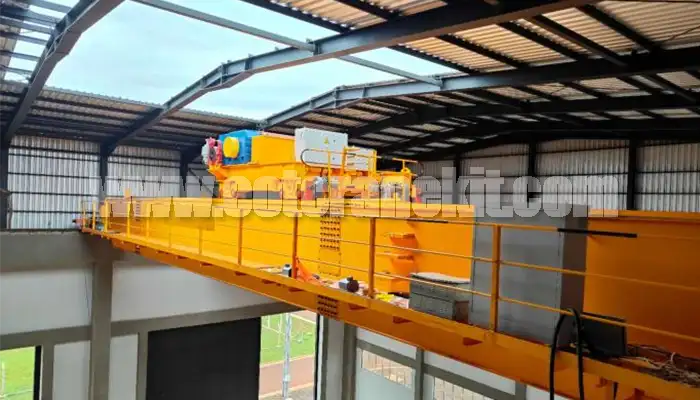
Latest project
150 Ton Overhead Crane Installation Feedback – Paraguay Case
QDX 150 ton overhead crane in action in Paraguay. Installation photos, video, and client feedback show performance, safety, and heavy-lifting efficiency.
Free consultation to Confirm Parameters & Specifications and Get
Latest Crane Price & Crane Rate.
- Types of overhead cranes : _______?
- Optional: Overhead travelling crane, goliath gantry crane,Slewing jib crane, Single girder or double girder crane,small portable crane or kbk crane, etc.
- Capacity of overhead crane: _______?
- Optional: 0.25ton, 0.5 ton, 1 ton, 2 ton, 3ton, 5 ton, 10 ton,15ton, 20ton, 25 ton, 30ton,35ton, up to 550ton, etc.
- Crane span & lifting height : _______?
- Crane travelling length : _____?
- Control of overhead crane:_______?
- Optional: pendant/ remote/cabin control
- Voltage supply of overhead crane:_____?
- Eg,: 380V50/60HZ,3Phase or others,etc.
- Application/usage of crane:_______?
- Eg,: Steel mill, ,injection mold, cement,stone, concrete,granite, general manufacturing, etc.
Just leave a message via the contact form and our hoist and crane engineer will contact you with in 24working hours.
Get In Touch
